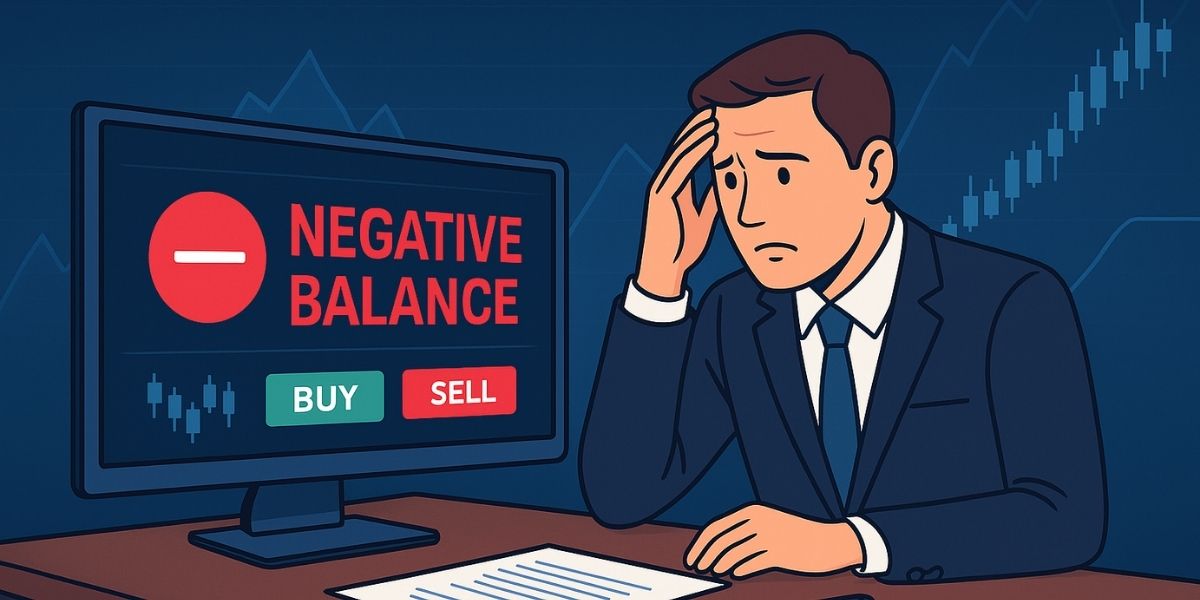
Most people think the worst outcome in trading is losing the money they put in. But what if your losses go further and you end up owing your broker money? It may sound unlikely, but under the wrong conditions it can happen.
This article explains how traders can fall into debt, why it happens more often with certain brokers, and what protections exist to prevent it. As more people try leveraged trading and as unregulated brokers keep advertising, knowing how to protect yourself has never been more important.
Key Points to Keep in Mind When Choosing a Broker
Mechanics of Broker-Induced Debt
At the core of this issue lies the use of financial leverage. Leverage allows traders to open positions larger than their account balance by effectively borrowing from their broker. While this amplifies profit potential, it also exponentially increases the risk of loss.
For example, a trader with £1,000 in capital who uses 1:100 leverage can control a £100,000 position. A 1% adverse move in the market could eliminate the entire capital base. In extreme volatility, such as during geopolitical events or unanticipated market announcements, the broker’s systems may not react fast enough to close the position, especially if the markets gap. This delay can result in the trader’s account falling into negative territory.
In these situations, unless the broker offers negative balance protection, the trader has to pay back any money they owe if their account goes below zero. This isn’t just a hypothetical risk, there have been real cases where everyday traders were asked by brokers to pay back large sums after disastrous trades.
Historical Precedents of Excessive Trader Losses
Several well-known events have demonstrated the real-world risks of owing a broker money. Among the most cited:
2015: Swiss Franc Revaluation
On January 15, 2015, the Swiss National Bank (SNB) unexpectedly removed its currency peg to the euro. This caused the Swiss franc (CHF) to surge by as much as 30% in minutes. Currency pairs such as EUR/CHF experienced massive gaps, bypassing stop-loss orders entirely. Retail traders caught in these positions suffered losses far exceeding their account balances. Regulated brokers were, in most cases, able to shield clients from negative balances, but many offshore brokers passed the losses directly to traders or collapsed under the pressure.
2020: Negative Oil Pricing
In April 2020, due to a combination of collapsing demand, storage issues, and technical market mechanics, U.S. crude oil futures (WTI) went negative for the first time in history. Retail traders long on oil were unprepared for this event. On certain platforms, they were unable to close positions, and incurred liabilities as their contracts settled below zero. Again, in the absence of protective regulation, clients were left with significant losses.
These examples underscore how volatile markets, when combined with poor broker risk controls or lack of regulation, can result in traders being left financially exposed.
The Regulatory Safeguards Provided by Authorised Brokers
The role of financial regulation in mitigating trading risk cannot be overstated. Brokers authorised by regulators such as the UK’s Financial Conduct Authority (FCA) and the EU’s European Securities and Markets Authority (ESMA) are legally obliged to implement key investor protections:
By contrast, brokers operating from loosely regulated jurisdictions are not bound by these requirements. They may offer excessive leverage (500:1 or more), unclear dispute resolution procedures, or misleading terms of service. Once funds are deposited with such brokers, retrieval can be difficult, particularly when no consumer protection body exists to intervene.
The Essential Role of Negative Balance Protection
Negative balance protection is like a safety net. It makes sure traders cannot lose more than the money they put in, even when markets behave unpredictably. In the UK and EU this protection is required by law, not something extra you have to pay for. It matters most during sudden shocks such as flash crashes, big economic announcements, or times when trading is thin and prices move sharply.
Without this safeguard, traders are left to cover extreme losses themselves, something most people are neither ready for nor able to handle.
If a broker does not clearly state that it offers negative balance protection, treat that as a red flag. Often the lack of this feature is not an accident but because the broker operates in places with weaker rules or fewer protections.
Frequently Asked Questions
What Should I Check Before Opening an Account?
- Confirm the broker is regulated (FCA, CySEC, ASIC, etc.)
- Look for clear negative balance protection
- Make sure client funds are kept separate from company funds
- Check if they are part of a compensation scheme like the FSCS
- Ensure there are proper dispute resolution channels
Smart Trading, Safer Outcomes
Retail traders should not see the possibility of owing money to their broker as abstract or unlikely. It is a very real risk when trading with unregulated or poorly supervised firms. The chance of losing more than you deposited is especially high in fast‑moving markets, and without proper safeguards the financial consequences can be severe.
Regulated brokers greatly reduce this risk by enforcing protections such as negative balance protection, segregated client funds, and financial compensation schemes. These are not just regulatory formalities; they are essential safety nets for traders in highly leveraged and volatile markets.
Ultimately, the responsibility lies with the trader to choose brokers carefully. Due diligence is essential. Make sure your broker is authorised, transparent, and offers meaningful protection. A broker should never leave you in a position where a bad trade turns into personal debt.
Financial markets will always involve risk, but those risks should be manageable, clear, and limited to the capital you choose to invest, not a penny more.

